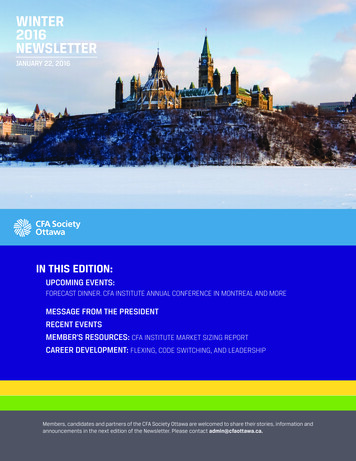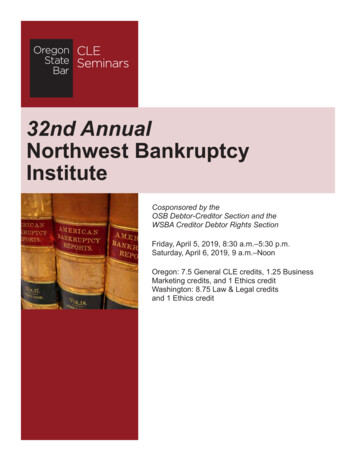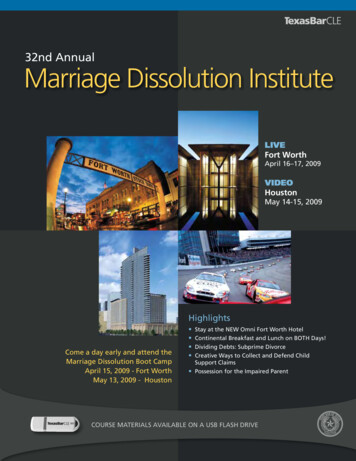
Transcription
32nd ISSUE Winter 2016/17community newsInternational Centre for Excellencein Emotionally Focused TherapyVision StatementICEEFT is the home and centre for mentalhealth professionals committed to expandingEmotionally Focused Therapy in the worldand creating a professional network for thoseinterested in this model.A Welcomefrom theDirector6Supporting Families fromthe “Inside Out”Alair OlsonSue Johnson8EFT Trainers Around theAcademic GlobeLeanne CampbellKathryn RheemBy the time you read this, 2017 will have arrived andcelebrating the holiday season will be over. Or willit? Why not celebrate all year? Perhaps this is a crazyidea but I often like crazy ideas and I like celebrating . AND there is (and will be) a lot to celebrate. Yes,our lives can be difficult at times and the world canoften be confusing, depressing and frustrating, butYES, we can choose to celebrate regularly. We cancelebrate our personal relationships, our professionalrelationships and this EFT family. We can celebratefriends and family, and celebrate that we get tochoose what matters to us and recognize that we areblessed in many ways.9Creating Ripples: EFT in IsraelOsnat Cohen Ganor12So Your Supervisor SaidYour Tape Wasn’t QUITECertification-WorthyJennifer BalleriniFrom an ICEEFT perspective, I want to celebrate youall. YOU have enriched my life. The growth of thisband of EFTers is nurturing to me and I hope, to all ofyou also. We can all celebrate the many new therapistswho have discovered EFT and the numerous new EFTFEATUREARTICLESREGULARFEATURES1A Welcome fromthe DirectorSue Johnson2Therapist Toolbox:Moving Therapist’s FocusBetween Partners in HighlyEscalated CouplesLieven Migerode54th International EFTSummit 2017Why Learning EFT Can Be 13 ICEEFT NewsHarder for ExperiencedClinicians21 2016 EFT Trainers’ RetreatLee SchneyerKathryn Rheem15 Finding the Missing Piece— EFCT with Muslim /23 News from the EastIranian ClientsWashington / NorthernRoza KorshidiIdaho EFT Community18 Harvard Grant StudyCarol Ann ConradDiscovers that We NEEDConnection — EFT24 Contact InformationExplains WHYAda Pang1419A Postcard fromWashington, DC: “CreatingConnections” 2016David FairweatherLeanne Campbell
the EFT community newsmany to list here in this message.Communities that are forming (see page 17 for theseven who affiliated with ICEEFT in just this pastthree months.)I hope to see you and celebrate with you all at theOctober, 2017 EFT Summit in San Diego.I hope you enjoy this newsletter issue. Yet again,several of you have written terrific articles — tooSueMoving Therapist’s Focus Between Partnersin Highly Escalated Couples (Stage 1)EFT for couples is a model of therapy that isboth experiential and systemic. EFT exploreseach partner’s inner experience and weavesnew interactions between partners. Alternatingattention from one partner to another is thereforekey in EFT. In Stage One, and particularly in Steps1 and 2, this alternating focus from one partner tothe other is more frequent than in later stages oftherapy. In Stage Two, sessions often contain longerperiods of individual exploration in the presence ofthe other, eventually followed by an enactment.Lieven Migerodeunlearn.The therapist explores the view and experienceof partner A, who speaks critically or in negativewords of partner B. Then she moves to the otherpartner and asks “What do you feel about this?” or“What do you think about this?”Wife 1: “She never pays attention, especially when Ifeel down she goes to her laptop.”Therapist to wife 2: “What do you feel when you hearthis?”It strikes me in training and during supervisionthat this moving from one partner to another inthe session can be difficult. It is the exact phrasingand pacing of this moving between partners thatproves to be a difficult exercise. This toolbox articlewill first describe an intervention to avoid becauseit promotes more conflict. Then, two preferableinterventions that fit with EFT and diminish actualfighting in the therapy room will be described.Wife 2: “I always do it wrong, it makes no sense talkingwhen you see me through a dark lens, can you dosomething else than just complain?”Wife 1: “You see, you cannot talk to her, always playingthe innocent.”What is happening here? One partner is complainingor describing the other in a negative perspective.When asked how she feels/thinks about this, theother partner is driven into the cycle and the cycleis further activated by the therapist’s question.Of course, she does not like this when she hearsa negative comment! Reactivity is unknowinglypromoted. Sometimes the therapist in training/supervision then complains that the session is1. An intervention to avoid: Tension increasetriggered by therapist.Sometimes we therapists have adverse effectsdespite our best intentions. The following so called‘escalation promoting intervention’ is well intendedbut is an adverse therapist action to avoid and2
32nd ISSUE Winter 2016/17always escalating.angry show itself then?” (exploring action tendency)For the sake of the example I kept the exploratoryinterventions of the therapist short. However, aslong as the client’s answers include some ‘criticism,’moving from partner A to partner B with thisquestion enhances the probability of more fighting/escalation in the session.Wife 1: “Well I think I might look angry and maybe saysomething sharp or edgy.”Therapist to partner B: “When your wife looks angryand says something sharp or edgy, what happensinside you, what do you feel?” (Taking both theemotional experience and the action tendency ofpartner A to the other and exploring partner B’sreaction to the trigger action tendency).This is why:In this intervention the EFT therapist does nottake the complaint from one partner to the otherdirectly. He works inside the ‘infinity loop’ andfirst connects the pursuing partner to her innerexperience, then links this experience/emotionto an action tendency, and then brings this actiontendency to the other partner to explore her innerexperience. This is ideally repeated until the cyclecloses. This sequence can then be concluded witha reflection of one complete loop of the cycle. Thisintervention has a triple effect on de-escalation.First the therapist works with the complaint beforebringing it as an exploratory tool to the otherpartner. This enhances the vulnerability of partnerA and diminishes the direct impact of her words ascomplaints. Secondly, by exploring the experienceof partner B, she is brought into the room in a moreengaged way. Thirdly and most importantly, inthis stage of EFT, the couple can start to ‘feel’ thecomplete cycle as the ‘enemy’.2. Preferred ways to weave.Depending on our aim in this stage of therapyand depending on the interactions in the room,the therapist can focus more on experiencing thecycle, or preferably, attempt to work on deepeningthe experience of both partners. Intervention 2.1focuses more on the cycle and will be used morein Step 2, while intervention 2.2 focuses more onexploration and will be used more in Step 3.2.1. Bringing the experience of the cycle alive inthe session.In this intervention the movement from one partnerto the other is made starting from the actiontendency of the emotion. The therapist then ‘carries’the behaviour from one partner to the other andexplores the emotional effect of this action, whichallows the cycle to be experienced.Wife 1: “She never pays attention, especially whenI feel down, she goes to her laptop.” (complainingangry tone)Therapist: “How do you feel when you have theimpression your wife is not paying attention?”(exploring emotional impact of perceived action ofpartner)Wife 1: “I feel neglected of course, and angry.”Therapist: “And how does this feeling neglected and3
the EFT community news2.2. Bringing gifts from one partner to the other:unwrap/wrap/unwrap/wrapIn this intervention, more time is taken for deeperexploration. Typically, a couple allows for this typeof intervention when the alliance is strong andwhen escalation starts to slow down in the session.This allows for some initial contact with primaryemotions. Consequently, this way of weaving fromone partner to the other will fit more with Step 3work.Wife 1 : “She never pays attention, especially when Ifeel down she goes to her laptop.” (complaining angrytone)Therapist: “How do you feel when you have theimpression your wife is not paying attention?”(exploring emotional impact of perceived action ofpartner)Wife 1: “I feel neglected of course, and angry.”be repeated with the other partner. Here also wecan see a triple layer action towards de-escalation.The first two are the same as in the interventionsabove. The third aspect here of de-escalation aimsfor the slow introduction of primary emotions intothe cycle, being the core of EFT. In this third aspect,this intervention is a precursor of later enactments.Therapist: “I understand that you feel angry when youfeel neglected, can you let me in some more to thisanger?” (reflect and evoke unwrap)Wife 1: (softer) “It is so painful when she does notseem to notice me anymore, I immediately feel leftalone and scared.”Therapist: “So when you get angry, underneath youfeel neglected, which is very painful when you lovesomeone and you have the impression you are notseen, (validation) and then this pain shows up asanger. Am I getting this?” (Wrap up)Lieven Migerode, C PsychEFT Therapist, Supervisor & TrainerFounder of EFT BelgiumWINTERDVD SALEWife 1: “Yes!”Therapist to wife 2: “Can I ask you something? Whenyour wife explains that she feels pain when she hasthe impression that she is not seen, she says that thispainful feeling of neglect shows up as anger. What ishappening inside you when you hear her explain herinner world like that?”Select DVDs are on sale — mostavailable for digital download!In this intervention we explore more and workagainst escalation by slowing the process down. Wedo this by a small REV (Reflect – Explore – Validate )cycle followed by a summary of what we understood.It is this understanding of the inner world of thepartner that we then transfer to the other partner,that is why I call it a ‘gift’. The same process can thenClick here for sale price listor visit iceeft.com.Sale lasts until Feb. 154
32nd ISSUE Winter 2016/175
the EFT community newsSupporting Families from the “Inside Out”more attuned and responsive to their children. Myhope in sharing how “Inside Out” has influenced mypractice and inspired my clients is that you may finda way to incorporate this tool in your own uniqueways.An Inside & Outside StoryAlair OlsonThe movie “Inside Out” tells two stories: an “inside”story and an “outside” story. The “outside” storyfollows a young girl named Riley who moves withher parents across the country, leaving behind afamiliar neighborhood, school, friend group andbeloved home. As this story unfolds, we’re alsofollowing the “inside” story of Riley’s emotions,thoughts, dreams and longings as she movesthrough this major life transition.When I first discovered that Disney was releasinga movie focused on human emotion called “InsideOut,” I was fairly nervous about the messagesthat would be sent to thousands of parents andchildren. Were we going to get the same Disneyending where everything feels “good” by the end of90 minutes and everyone lives “happily ever after?”Of all Riley’s emotions, we get to know Joy, Anger,Fear, Disgust and Sadness. Most of Riley’s life upuntil this time has been full of moments of Joy, withoccasional smatterings of the other four emotions.However, as we all know, life transitions bring withthem a multitude of feelings if we let ourselvesexperience them. In Riley’s case, Joy tries everythingin her power to stay front and center for the sake ofhelping Riley through this difficult season of life, atthe expense of the other emotions. We slowly watchas both the inside and outside stories unravel: Riley’sinternal and external worlds become disorienting,confusing and off-balance.To my surprise and excitement, that was hardly thecase.Many of us in the EFT community offered similar,positive reflections about “Inside Out” via the ICEEFTListserv: “[The artists] created a colorful model foremotions, memory and attachment,” “[The movie]validates for both kids and adults that ALL emotionsare useful and play a role in our humanity,” “sendsthe message that vulnerability is the path toconnection and we need to support parents to invitetheir children into that vulnerability,” and “a greatmovie, and I am thinking of referring it to clientswho struggle with naming emotions.” I know manyof us wished parts of the movie had been differentand yet we also saw this movie as a small victory.By the end, the main message that comes throughloud and clear is that all emotions serve a purpose,are valuable and need to be heard. Both internaland external worlds are restored to balance whenall thoughts and feelings are included, even theones we normally try to exclude or minimize.“Inside Out” is particularly relevant and importantfor my practice, as the majority of my clients arefamilies with children between six and elevenyears of age. As I apply the Emotionally FocusedFamily Therapy (EFFT) model with these clients, Ihave repeatedly used this movie as a tool to helpchildren understand their own emotions and toassist parents in learning how they can becomeTools for KidsWhile it may seem a bit obvious as to how thismovie could be helpful to young children, I wantto highlight two ways in particular: emotionalawareness and congruency. I work with many6
32nd ISSUE Winter 2016/17children, but because they want their children tothrive and do well in life. This perspective can be abeautiful reframe for parents’ reactions, perceptions,emotions and longings regarding their children. (“Ofcourse you come down hard on your child. You’retired of seeing him/her get in trouble at school/havea meltdown/feel anxious about everything. Youwant your child to enjoy all that life has to offer.”)In the movie, Joy had a particularly special bondwith Riley, displaying an almost parental care andaffection. The parents in our offices are not muchdifferent and unfortunately their children miss outon seeing these profound intentions.young children who have little understandingabout the emotions they experience, let alone thattheir sensations or reactions are actually becauseof emotions. In my work with play therapy andEFFT, one of the greatest gifts I can give a child isgiving language to their internal world. “InsideOut” is an excellent start to naming, organizing,understanding and expanding children’s emotionalworlds. As Dan Siegel and Tina Payne Bryson writein The Whole-Brain Child, “What kids often need,especially when they experience strong emotions,is to have someone help them use their left brainto make sense of what’s going on – to put things inorder and to name these big and scary right-brainfeelings so they can deal with them effectively” (pg.29). One particular way I do this is to ask childrento draw or create what their own emotions looklike (“You know how in ‘Inside Out’ the feelingslook different, like Anger is red with fire comingout of his head? What would your Anger look like?What would it say?”). This kind of activity can givechildren (and their parents) a clearer window intotheir emotions.Even though she had great intentions for Riley, Joywent to extreme lengths in attempts to preventRiley from experiencing anything negative. In EFFTterms, we would say that a block arose wheneverJoy imagined that Riley would suffer to any degree.Many of my clients also have vivid imaginations,already picturing their six year-olds on theevening news or living on the streets or becomingdepressed and suicidal, if they are allowed to feelangry or sad or scared. So the parental blocks showup as minimizing, rationalizing, shaming, denying,ignoring and a whole host of others. In a uniqueway, this movie normalizes and explains how blocksshow up for parents who deeply love and care fortheir children. Just as children have a new languagefor their emotions, parents have a new perspectiveon why they react in certain ways toward theirchildren.This movie also provides children with an exampleof our “outside” and “inside” worlds. The majorityof parents who step into my office describe theirchildren as “defiant,” “manipulative,” “selfish” or“oblivious.” However, once I develop a relationshipwith these children and earn their trust, I learnthat they are actually “lonely,” “scared,” “sad” and“traumatized.” With this perspective in mind, I helpchildren recognize how their “big feelings” on theinside are often different than what their parentssee on the outside. At the same time, I also helpparents become more attuned to their children sothat children are able (and actually want) to havecongruent inside and outside worlds.“Inside Out” is a remarkable gift for our clients: tolearn how to live congruent lives, to name partsof us that feel confusing or overwhelming, andultimately to support families in learning how tolive in more connected, attuned ways.Alair Olson, MA, LMFTSan Diego, CATools for ParentsI believe that “Inside Out” has the potential toinfluence and affect parents far more than childrenbecause this movie validates parents’ intentions, aswell as highlights their blocks to accessibility andresponsiveness. I am learning to see parents as themovie character Joy: not because they are happy tobe in therapy or feel completely positive about theirWelcome!ICEEFT is pleased to welcome Jill Fischerto our newsletter Editorial Board.7
the EFT community newsEFT Trainers Around the Academic GlobeLeanne Campbell Rebecca Jorgensen has been teaching EFT asvisiting faculty at the Institute of Family Therapyand Systemic Practice Areopagues in Timosaraand Bucharest, Romania, and at Alexandru IoanCuza University of Iaşi, Romania. Becca is alsodoing introductory workshops for Linköping,Gothenburg and Stockholm Universities inLinköping, Sweden and for the Family Therapytraining program at Lund University, Sweden.Kathryn Rheem Jenny Fitzgerald has been teaching in theClinical Psychology graduate program at theUniversity of Queensland, Brisbane, Australiaand supervises UQ doctoral students in clinicalplacements at the Australian Centre for EFT.Jenny also teaches one day workshops in EFT atSwinburne University, Melbourne, as well as anEFT Externship to Swinburne Masters students.Part of the mission and vision of ICEEFT is tohave an involvement in universities, whether it beas a guest lecturer, a visiting professor, a facultymember or a clinical supervisor. This involvementis encouraged and celebrated! In addition toSue Johnson’s efforts, a recent survey of our EFTTrainers highlighted some of the many ways thatthey are contributing to spreading the word at thegraduate and undergraduate levels in academia.There are also many Trainers that have beencontributing to the dissemination of EFT in variousparts of the United States, including:There are so many noteworthy contributors aroundthe globe! Kyriaki Polychroni has been teaching at theUniversity of Athens, at ‘Deree, the AmericanCollege of Greece, at ICPS College, and has beena Visiting Professor at Hibiscus University inTimisoara, Romania. Karin Wagenaar has been teaching EFT as a partof the fourth-year post-graduate program forclinical psychologists in the Netherlands. Hanna Pinomaa has been involved in introducingEFT at the Oulu University in the northern part ofFinland. Lieven Migerode has been teaching EFT as partof the four year post-graduate (post masters)training program in marital and family therapyfor psychologists and psychiatrists at theDepartment of Psychology of the KULeuven(Catholic University of Leuven). Dimitrij Samoilow (Trainer-in-Training) has beenteaching family therapy seminars at the Universityof Oslo, Norway. The course involves eight sessionswith EFT as the focus for one of the sessions. Kenny Sanderfer — Trevecca Nazarene University,Austin Pea University and Lipscomb University. Jim Furrow — Fuller University. Roy Hodgson and Kathryn de Bruin — WhitworthUniversity. Lorrie Brubacher — University of North CarolinaGreensboro. Annemarie Early — Eastern Mennonite University. Lisa Ruderman and Kenny Sanderfer — SecondCalifornia Baptist University in Riverside. Jette Simon — Graduate School of Education,Fordham University, New York. Zoya Simakhodskaya — New York UniversitySchool of Medicine; City University of New York;Graduate School of Applied and ProfessionalPsychology at Rutgers University; Mt. SinaiHospital and School of Medicine; MontefioreMedical Center; and Einstein School of Medicine. Scott Woolley — Alliant International University,San Diego, Couple and Family Therapy Program;University of Nevada Las Vegas, Center for8
32nd ISSUE Winter 2016/17Individual Couple and Family Counseling; ArgosyUniversity, Marriage and Family Therapy Program(Draper, Utah).graduate students and interns, and Psychiatryresidents. Gail Palmer has been teaching at Oxford(Oxfordshire, England, UK), and at Sir WilfredLaurier University (Ottawa, Canada), and wasrecently appointed to the graduate faculty at SirWilfred Laurier University. Rebecca Jorgensen — Institute of Family Therapyand Systemic Practice; University of TexasArlington, School of Social Work; University ofNevada Las Vegas, Center for Individual Coupleand Family Counseling; University of Phoenix,Summerlin Campus, College of Social Sciences(Las Vegas); Argosy University, Marriage andFamily Therapy Program (Draper, Utah); andAlliant International University, California Schoolof Professional Psychology in San Francisco, SanDiego and Sacramento. Normand Gingras has been teaching atOttawa University and Université du Québecen Outaouais (UQO), and at Centre HospitalierUniversitaire Vaudois in Lausanne Switzerland.As EFT also continues to take flight and enjoysgrowing recognition around the globe, we honorthese many contributors and others as well, whohave spread the merits of this transformationalapproach, teaching a new generation of studentshow to practice EFT. A primary objective for ICEEFTin the years to come is to provide EFT-related skillsand knowledge to therapists in the early stagesof their clinical development in order to providea foundation on which to build throughout theircareers and thus help ensure that couples andfamilies throughout the world grow strong bondsnow and for decades to come!In closer proximity to the home of ICEEFT (Ottawa,Canada), we celebrate the contributions of thefollowing EFT Trainers: Paul Greenman is a full professor at the Universitédu Québec en Outaouais (UQO), in Gatineau,Québec, Canada. He is also a member of theFaculty of Graduate and Postdoctoral Studies,affiliated with the School of Psychology, at theUniversity of Ottawa, and has on two occasionsbeen a Visiting Professor in the School of HealthPsychology at the Sapienza University in Rome,Italy (Jan-May 2015 and May-June 2016).EFT Therapists, Supervisors & Trainers:Leanne Campbell, PhD, R PsychVancouver Island Centre for EFT Marlene Best is a Clinical Professor in the Schoolof Psychology at the University of Ottawa whereshe has been teaching and providing clinicalsupervision for many years to Clinical PsychologyKathryn Rheem, EdD, LMFTDirector, Washington Baltimore Centre for EFTCreating Ripples: EFT in Israelfurther into your communities, practices and lives.Every journey has its heroines, helpers and dragons.Our journey wasn’t without hardships but I must saythat the powerful pull of EFT has eased the way. Iwant to share with our worldwide community howthis amazingly fulfilling dream came true and howthe Israeli EFT community affects others.Osnat Cohen GanorThe first Externship in Israel is behind us “withflying colors.” There was a huge buzz about andno openings were left in the November 2016 CoreSkills, so it was a good time to step back and look athow this vision unfolded. The Externship was trulyThis article is about a journey. I believe it willresonate with so many of you who accidentallystumbled into EFT, fell in love with it and took it9
the EFT community newswas that Sue’s work didn’t just conceptualize, butreally had a unique technique to foster secureattachment. I remember asking Elana to bring theExternship to NYC. Luckily, it was part of her visionand a year later in 2008, she launched what wouldbecome the annual NYC Externship sponsored bythe Ackerman institute. I was glad to participate inthe first EFT Externship in NYC.a wonderful experience with 80 participants! ElanaKatz and George Faller were both amazing andswept the local community off their feet. They wereso patient and generous and we appreciate theirwillingness to fly such a long distance.In the spirit of EFT we were not alone — we hadthree wonderful supervisors join us as helpers. RitaVentura from Greece helped in so many ways. (Hersupervisee, Leo Kalovyransates brought a couplefor the live). We had Neil Weisman and Aviva Reizelfrom the United States, their true thankfulness forEFT in Hebrew moved everyone and colored theworkshop with so much grace. With therapistsfrom the Greek community also joining us, it wasa truly world-wide effort! Our Israeli team, Dr. OfferMaurer, Dr. Rivka Tuval Mashiach, Ora Haushner,Miri Chachnai and I, helped greatly as well. Thisevent took place at IDC-Interdisciplinary CenterHerzzeliah, one of the leading schools of psychologyin the country, and provided a great environmentthat eased the journey into new territories andfostered the learning experience. It was a wonderfulcollaboration between Elana, who mentored us inthe process, and the detailed work orchestratedby my dear friend and colleague Dr. Offer Maurer.We couldn’t do it without his thoughtful caring forevery little detail, including the ending song whichI believe was put on the ICEEFT listserv. People werefilled with “love sense!”After finishing Core Skills with Elana and George in2009-2010 and just before coming back to Israel, Iknew I wanted to be part of this. In a little Italianrestaurant on the East Side with white and redcheckered tablecloths and good Italian pasta, Suegave me her blessing and support to bring EFT toIsrael.Most of this was still unheard of here in Israel andupon coming back, it was hard to see how to go aboutit. As always on journeys, little miracles happenedand in 2010 I was very privileged to become part ofa research team at IDC. From that team, the dreamof creating a home in Israel for this changing worldof psychotherapy found a route. Dr. Offer Maurerbuilt the first psychotherapy school that gaveroom to approaches that emphasized attachmentresearch, emotions and integrative work. We werefive visionaries holding hands in hopes things wouldfly. We had people streaming in, drinking up thesenew ideas and wanting more. It became a uniquealternative to the polarized split between dynamictherapy and the cognitive world that is huge here inIsrael. We slowly grew. EFT could be taught throughthis new school. I taught nine courses in the last fouryears. Lecturing around the country we expecteddragons to appear protesting against or resistingour new way. But we actually found more and moresupporters and people who opened their heartsto change. The ground was well set for the firstExternship and Elana had approached me. But afterthe first Externship was set, a dragon in the form ofwar, came along and we had to postpone it. It tookanother year and a half yet that gave us more timeto prepare. More therapists were looking to learn EFTand more clients were asking for an EFT therapist.Although we had differences in culture and pace, wehad a shared vision and we learned to work together.The live interview was nothing short of remarkable.George shared with us his deep yet dazzling work,helping us to see how the withdrawn partner needsto be attended to, to help Stage 2 take off. It wasmoving to see the empathic response of the partnerand the closeness that was created by the end ofthat session.EFT has the power to change couples’ dynamics,our identities as therapists and here in Israel, it hasbecome a major part in creating a change in thefield of psychology.It started in NYC in 2007 when I first met EFT andSue at a lecture.It was a revelation. At the time I was heavilyinvolved in relational theory and had started to seehow important attachment is. Yet what was strikingEver since my training in the US, I have been10
32nd ISSUE Winter 2016/17psychotherapy program at IDC, who created thenew school of psychotherapy in 2011 as a homeof attachment, emotion and research-basedtherapies, and made it an official post-gradschool of psychotherapy in 2016. Without hisamazing vision, optimism and support and hishard labor we wouldn’t have had this new space.immersed in learning EFT, practicing and passingon this model but that couldn’t have been achievedwithout a lot of support and an attachment figureof my own — my fairy godfather — George Faller,a great supervisor and mentor. He took uponhimself the mission of helping me become a bettertherapist and instructor and was willing to findout about a different culture and how to reachpeople in a different life setting with differentstruggles. Alongside was our fairy godmother —Sue’s support and time Skyping with us helped thelocal community to feel connected and recognized.People were thankful and spread the word further. Professor Sue Johnson, the creator of EFT, forher amazing, innovative work and body ofresearch. Sue’s fascination with relationshipsand her relentless effort to turn love into anunderstandable phenomenon has created amajor shift in the world of couple’s therapy.Her important understanding that love is anattachment bond and her creation of the EFTmodel has given us a map and way to bringcouples into secure attachment.With the help of Mario Mikulincer, a world-renownedIsraeli attachment researcher and the dean of theschool of psychology at that time, the “new school”could start bringing i
Sue Johnson community news 32nd ISSUE Winter 2016/17 FEATURE ARTICLES REGULAR FEATURES 2 1 International Centre for Excellence in Emotionally Focused Therapy Vision Statement ICEEFT is the home and centre for mental health professionals committed to expanding Emotionally Focused Thera










